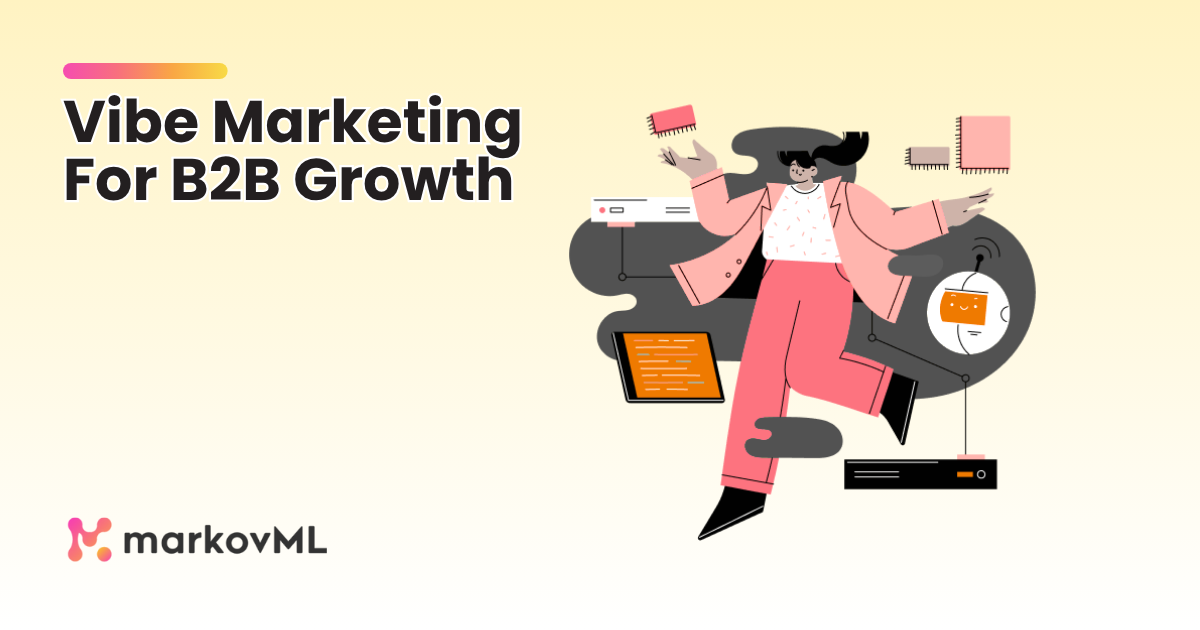Vibe Marketing: An AI-Powered Strategy For B2B Growth

Vibe marketing is changing the way B2B software companies run their campaigns by combining the efficiency of AI with the creativity of people shaping brands that real people can relate to.
Originating from "vibe coding," a term coined by OpenAI's Andrej Karpathy, vibe marketing replaces long, complicated processes with self-driving AI agents that do the work, allowing marketers to focus on strategy and emotional storytelling.
Why Vibe Marketing is the Best B2B Strategy for 2025
- Smaller teams, bigger output
According to a Gartner CMO survey, marketing budgets went down to 7.7% of company revenue (from 9.5% in 2023), which meant that CMOs had to do more with less. With AI tools like ChatGPT and Midjourney, one marketer can now do the work of five specialists, cutting campaign times, costs, and efforts.
- Emotional Connection > Feature Lists
71% of B2B buyers prefer brands that have emotional clarity in their thought leadership, but most content reads generic. Vibe marketing puts a brand’s main emotion (like Notion's calm or Figma's playful) into every asset.
- Hyper-Personalization at Scale
AI looks at first-party data to generate 1,000+ pieces of content that are targeted towards small groups. PepsiCo used AI tools to cut the time it took to make assets from 2-3 hours to 2-3 minutes, with human-led guidance.
Core Principles of Vibe Marketing
Key Mindset Shifts:
- AI is a copilot, not a captain. Tools do the work, and people train the AI on cultural and emotional nuances to understand sentiments and cultural differences.
- Launch fast, refine faster. Prioritize completion over perfection. Use real-world feedback over internal debates for refinement.
Vibe Marketing Challenges and Solutions
- Generic AI output
Challenge: Without the human touch, AI outputs can sound the same across all brands.
Solution: Implement human guardrails to check and optimize AI output for consistency and brand voice.
- Ethical gray zones
Challenge: Using AI for personalization raises concerns about data privacy. Solution: Be transparent on AI use while also complying with the regulations of personal data usage.
- Execution chaos
Challenge: Unstructured and disjointed workflows lead to inconsistent messaging.
Solution: Make modular content systems (for images, subject lines, CTAs, etc.) that take context from various workflows.
Your 90-Day Vibe Marketing Launch Plan
Phase 1: Foundation (Days 1–30)
- Start with an audit of your current marketing activities. What are the tasks that you do repeatedly that could be delegated to AI? Writing emails? Posting on socials?
- Prepare your toolkit. What are the AI tools that could take over these tasks? Maybe Jasper for content, Canva AI for image creation.
- What is the emotion associated with your brand? Companies like Notion (calm, productive) have nailed down their brand personality pillars to create consistent messaging.
Phase 2: Integration (Days 31–60)
- Build agents. Use platforms like n8n and integrate your tech stack and AI tools to create your virtual marketing team. Use existing high-performing content to teach tools how to sound like your brand.
- Onboard your teams. Show product and support teams how to use, analyze, and refine the AI tools and systems.
Phase 3: Scale (Days 61–90)
- Automate optimization to automatically change ad bids, A/B test creatives, etc.
- Monitor dark socials. Use AI to keep an eye on Slack and Reddit for less obvious intent signals. Also collaborate creatively as a team to brainstorm good intent signals as you have a deeper understanding of your ideal user and customer.
The Future: Vibe Marketing vs. Traditional/Slow-Motion Marketing
As vibe marketing gains market traction, slow-motion marketing is touted as the antidote. Slow-Motion Marketing is a movement that opposes vibe marketing because it says it puts speed over substance. Critics want:
- Intentional Friction: Giving people room to think strategically (for example, "Is this campaign true to my brand?").
- Mixed Approach: Use AI's speed and human judgment together. AI executes, while humans are in the driver’s seat.
In the end, vibe marketing isn't taking the place of marketers; it's taking the place of bloat. Those who use AI to boost creativity, not automate it, will win.
In 2025, companies use vibe marketing to:
- Cut CAC by targeting the right audiences
- Get ahead of the competition with fast-moving content
- Create brands that feel "familiar and human" in a world full of AI noise
If you’re unsure if vibe marketing is for you, try a hybrid resonance that fits with your brand, while gradually experimenting and building towards fuller AI adoption.
Let’s Talk About What MarkovML
Can Do for Your Business
Boost your sales journey with MarkovML today!
.svg)

.svg)

.svg)